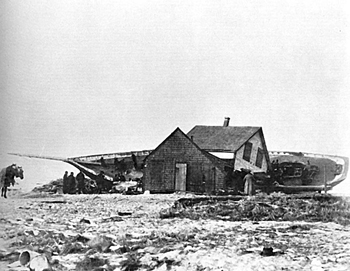BACK THEN
Heavy Weather

The pilot schooner Columbia at Scituate MA, 1898. The 4 year old vessel was thrown from the water and smashed against a house. The same storm took the steamer Portland.
The pilot boat “Columbia” thrown from the water and smashed against a house at Scituate, Massachusetts in a November, 1898 storm. The four-year-old schooner was a total loss, as was its five-member crew. The “Columbia#” was one of 140 major vessels wrecked or sunk in the storm that lasted more than 36 hours. The storm surge threw many large vessels onto curious shore perches. The most noted vessel lost was the steamer “Portland,” after which the storm was named. The story of the loss of 200 lives on the “Portland,” the circumstances under which it left the wharf in spite of changing weather conditions, the recovered watches of passengers frozen at 9:15 and the mystery surrounding its whereabouts have been told many times in the last 100 years.
The more recent documentation of where the “Portland” went down and the condition of the remains have answered some questions and raised others. The hull is in tact, but the lightly-built superstructure was demolished, wiped off and none of the wreckage from it was found in the area around the hull. The passengers may have spent as much as 26 gruelling hours aboard in very heavy snow, wind and seas. Out of fuel, they were without heat or lights. Many no doubt, perhaps all, were blown overboard when the superstructure was washed away. Did a wave break over the the boat? Did the boat broach and roll? How far did it drift after the superstructure and engine went overboard?
The Portland Gale has been compared to the Halloween Storm of October 1991. That storm was described as a perfect storm in the book of the same name. There is not enough known about the Portland Gale and meteorologists at the time did not have the upper atmospheric information, etc. to know if it was a perfect storm.
From the direction that the “Portland” was driven by the storm, south, the heavy snow and the time of year, it looks more like a pumped up nor’easter than a perfect storm. A perfect storm is a hybrid storm. The November, 1991 storm grew out of the collision of a tropical storm that had gone offshore and Hurricane Grace that was traveling north. Grace was losing strength when the two collided, they pinwheeled around each other in a figure eight in the northwest Atlantic; Grace was absorbed, creating a new storm. Grace’s moisture and warm core fed the storm. After joining, it then it headed back toward shore.
There were lives and boats lost in 1991, but 100 years ago the number of lives lost in these storms was often much higher. The nearly 200 lives lost on the “Portland is one reason it is remembered. The hurricane that devastated Galveston, Texas September 8, 1900 took 8,000 lives, and was the deadliest in U.S. history. It was a Category 4 storm and generated 8-15-foot tides over a flat, sea level landscape. Today these storms are more likely to be measured in property damage. New technology to monitor weather systems, and warn communities in their path, have reduced casualties. In August of 1992 hurricane Andrew killed 65 people and did 27 billion dollars in damage. The area around Homestead in southern Florida was so wiped out, surveyors had to come in to layout the streets again. Andrew was a Category 5.
Hurricane Katrina was a category 3 by the time it made landfall in coastal Louisiana in August of 2005. At least 1,836 people lost their lives. It was the largest natural disaster in U.S. history with total damage of $81 billion in 2005 USD. The storm surge produced most of the damage. Hundreds of large boats and barges were thrown several miles inland smashing buildings along the way. Thousands of residents remain displaced to this date. Category 5, the strongest hurricane, has winds over 155 mph, with gusts to 200. Physics governs the hurricane’s wind speed limit at 200 mph and an eye diameter of 5 miles.
